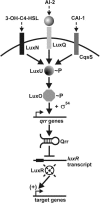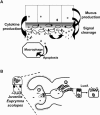Decoding microbial chatter: cell-cell communication in bacteria
- PMID: 16077095
- PMCID: PMC1196057
- DOI: 10.1128/JB.187.16.5507-5519.2005
Decoding microbial chatter: cell-cell communication in bacteria
Figures




Similar articles
-
Microbial dinner-party conversations: the role of LuxS in interspecies communication.J Med Microbiol. 2003 Jul;52(Pt 7):541-545. doi: 10.1099/jmm.0.05128-0. J Med Microbiol. 2003. PMID: 12808073 Review.
-
Exploration into the spatial and temporal mechanisms of bacterial polarity.Trends Microbiol. 2007 Mar;15(3):101-8. doi: 10.1016/j.tim.2007.01.004. Epub 2007 Feb 1. Trends Microbiol. 2007. PMID: 17275310 Review.
-
Use of genome-scale microbial models for metabolic engineering.Curr Opin Biotechnol. 2004 Feb;15(1):64-9. doi: 10.1016/j.copbio.2003.11.003. Curr Opin Biotechnol. 2004. PMID: 15102469 Review.
-
"Neural networks" in bacteria: making connections.J Bacteriol. 2005 Jan;187(1):26-36. doi: 10.1128/JB.187.1.26-36.2005. J Bacteriol. 2005. PMID: 15601685 Free PMC article. Review. No abstract available.
-
A new bacterial chemical signal: mapping the chemical space used for communication.Chembiochem. 2014 Mar 3;15(4):498-500. doi: 10.1002/cbic.201300758. Epub 2014 Jan 16. Chembiochem. 2014. PMID: 24436307
Cited by
-
Assessing the Molecular Targets and Mode of Action of Furanone C-30 on Pseudomonas aeruginosa Quorum Sensing.Molecules. 2021 Mar 15;26(6):1620. doi: 10.3390/molecules26061620. Molecules. 2021. PMID: 33803983 Free PMC article.
-
Cracking the code: a comparative approach to plant communication.Commun Integr Biol. 2021 Aug 17;14(1):176-185. doi: 10.1080/19420889.2021.1956719. eCollection 2021. Commun Integr Biol. 2021. PMID: 34434483 Free PMC article. Review.
-
Stability of multispecies bacterial communities: signaling networks may stabilize microbiomes.PLoS One. 2013;8(3):e57947. doi: 10.1371/journal.pone.0057947. Epub 2013 Mar 4. PLoS One. 2013. PMID: 23483950 Free PMC article.
-
Molecular and Biochemical Characterization of YeeF/YezG, a Polymorphic Toxin-Immunity Protein Pair From Bacillus subtilis.Front Microbiol. 2020 Feb 14;11:95. doi: 10.3389/fmicb.2020.00095. eCollection 2020. Front Microbiol. 2020. PMID: 32117125 Free PMC article.
-
The Less Expensive Choice: Bacterial Strategies to Achieve Successful and Sustainable Reciprocal Interactions.Front Microbiol. 2021 Jan 20;11:571417. doi: 10.3389/fmicb.2020.571417. eCollection 2020. Front Microbiol. 2021. PMID: 33584557 Free PMC article. Review.
References
-
- Barber, C. E., J. L. Tang, J. X. Feng, M. Q. Pan, T. J. G. Wilson, H. Slater, J. M. Dow, P. Williams, and M. J. Daniels. 1997. A novel regulatory system required for pathogenicity of Xanthomonas campestris is mediated by a small diffusible signal molecule. Mol. Microbiol. 24:555-566. - PubMed
-
- Bassler, B. L., M. Wright, and M. R. Silverman. 1994. Sequence and function of LuxO, a negative regulator of luminescence in Vibrio harveyi. Mol. Microbiol. 12:403-412. - PubMed
Publication types
MeSH terms
Substances
Grants and funding
LinkOut - more resources
Full Text Sources

